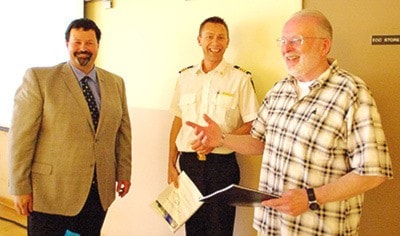In the event of a major disaster, Sidney has the infrastructure at the ready to help its residents — but it stands to improve.
Those were the findings of a group of Royal Roads University students taking their masters degree in Disaster and Emergency Management. Over the last few months, the group has been meeting with local officials, emergency services and business owners to see how Sidney stacks up to a United Nations risk reduction model. Peter Lemieux, from Edmonton, says overall Sidney did quite well.
“There’s always an opportunity to become more resilient,” he said. “Sidney needs to collect independent plans and come up with an overall strategic plan.”
Those independent plans, he explained, are those created by different organizations, levels of government and businesses. This, however, is not unique to Sidney, Lemieux said, noting that it’s a fairly easy fix.
What that will do, he continued, is help ensure that in the event of a disaster, all efforts to recover are coordinated and there’s a plan in place for business continuity. In the recent example of flooding in High River, Alberta, businesses there were forced out due to high water didn’t have plans to save their important documents. That, coupled with material losses has meant many businesses will not re-open.
The risk resilience report shows Sidney is making progress in most essential areas graded — from budgeting for a disaster and updating emergency plans, to installing early warning systems and education programs. Sidney is doing very well in performing risk and infrastructure assessments and enforcing realistic building regulations.
Councillor Tim Chad says he learned more than he was able to provide to the Royal Roads students. When asked what the Town will do with this report, Chad said they will use it as a road map.
“We can do a lot with it. We can do more of the things that are needed to reduce risk. We can make the Town a bit safer and ensure we get out of the way of the people doing the job and make sure they have the resources they need.”
Chad said this will help the Town create a new public safety plan.
Sidney Deputy Fire Chief Brett Mikkelsen asked with 400-plus business in Sidney’s downtown area, how can his department better engage them.
Lemieux said places like North Vancouver are working with chambers of commerce on education plans. Those help business owners realize the importance of having a disaster plan in place.
The risk report, now in the hands of the municipality, outlines Sidney’s performance in 10 essential areas, as well as where improvements can be made. Key findings, said Lemieux, include:
• good leadership and Town management
• little debt and high reserve funds
• a caring community
• excellent response capability
• stakeholders have emergency plans available.
The report also suggests both short-and-long-term fixes with the ultimate goal of making the community more resilient to disaster. Those range from joint exercises and creating flood zone maps, to updating emergency response plans and earthquake retrofitting.
The students’ primary recommendations are for more community engagement on the issues of risk and recovery and using education to mitigate potential losses in a disaster.
Lemieux said if Sidney works a bit harder, it can become a role model community in the U.N.’s resilient cities campaign.
